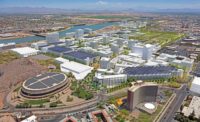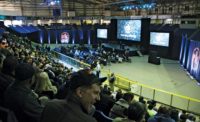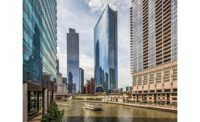By fulfilling its mission of putting clients first, Dallas-based CM and general contractor Structure Tone Southwest (STSW) stands second to none for an array of regional building owners and developers—including Abbott, Nokia and Oncor, Texas’s largest provider of electrical transmission and distribution. In all, some 80% of STSW’s work involves repeat business, according to Joseph Cribbin, president of the firm.
With 200 employees and revenue topping $519 million last year—up 28% from 2017—STSW, part of the STO Building Group family of companies, continues to cement new partnerships with clients from its Texas offices in Dallas, Houston, San Antonio and Austin. Recent repeat clients include Coppell, Texas-based office furniture supplier Vari, which hired STSW to reposition and renovate a 345,550-sq-ft Dallas-area building for purposes of creating and leasing flexible office space. Based on the results, Vari invited STSW to participate in a second similar venture and will continue to partner with the firm on future projects, says Jeff Lamb, Vari president. A key attribute is “Structure Tone’s ability to scale up with needed in-house expertise, be it structural or M/E/P, at the right time, when it’s needed most,” Lamb says.
“We’re unique,” says Cribbin, who notes that whether STSW is executing projects as modest as a conference room or as big ticket as a multibuilding corporate headquarters, the common denominator is the unyielding emphasis on safety, quality and executive support the firm offers at every turn, from preconstruction through close-out and turnover.
“We recognize that no two projects are the same,” says Tracy McWhorter, director of quality systems with STSW. “You’re not going to succeed unless you treat each project—and each client—independently.”
That philosophy has propelled development of a highly diversified client base, prompting STSW to establish operating units dedicated to interior construction, health care, mission-critical—notably data centers—and ground-up work, says Cribbin. The four units collectively cut across a variety of project types, including offices, manufacturing plants, warehouses, distribution centers, health care facilities, life science laboratories, pharmaceutical centers, hotels and retail space.
Ongoing client partnerships across a variety of sectors have proven key to accelerating growth. Last year alone, STSW engaged in 14.8 million sq ft of construction, including completion of interior fit-out work on a 1.23-million-sq-ft corporate headquarters for American Airlines in Fort Worth. Other recent projects include a 250,000-sq-ft office and lab facility for Nokia in Dallas and new facilities for the South Texas Biomedical Research Institute, a San Antonio-based biomedical research firm engaged in efforts to combat the COVID-19 virus.
At present, about 100 STSW employees operate in the Dallas office, with the remainder more or less evenly distributed in Houston, San Antonio and Austin. A vice president assigned to each of the three offices oversees operations and reports to Cribbin. Although employees ostensibly work within one of the firm’s operating units, the reality is more fluid. “If we need to scale up on a certain project, we’ll move some employees from one operating unit to the other,” says Cribbin. “We—and they—benefit from exposure to a variety of building types.”
High-Tech Tools
Project participation ideally begins in the preconstruction phase, allowing the firm to establish a rapport with client and designers at the outset, says McWhorter. In addition to cost-estimating and scheduling, the firm assists in identifying overlooked items and clashes, typically via building information modeling (BIM), with Autodesk’s Revit serving as the platform, he says. Preconstruction planning also facilitates early procurement of system components as well as creation of virtual walk-throughs based on data derived from modeling, Cribbin says. Both activities allow for a smooth start in the field. Laser scanning is yet another tool in the firm’s quality assurance arsenal, proving particularly useful in verifying dimensions—such as those for ductwork—in renovation projects. “As-built drawings aren’t always accurate, particularly in the case of older buildings,” says McWhorter. Laser scan results are integrated into the BIM model, with modifications made as needed, he adds.
During construction, STSW makes extensive use of the software app PlanGrid, a program that archives project drawings and can pair them with uploaded photos of actual installations as work on a project progresses, according to McWhorter. Accessible via iPad or iPhone, PlanGrid allows stakeholders to flag discrepancies between photos and drawings or link RFIs to the drawings and review them in real time, he adds. Assuming modifications are required, STSW can export rework requirements directly to subcontractors to review and address while monitoring the time required to do so, McWhorter says.
“You’re not going to succeed unless you treat each project—and each client— independently.”
– Tracy McWhorter, Director of Quality Systems, Structure Tone Southwest
STSW also is employing technologies such as OpenSpace, a program that photo captures 360-degree imagery of a site at 30-ft intervals on average via a device secured to hard hats, says McWhorter. After stringing images together, the program creates an email link to them, allowing remote stakeholders to essentially walk the site themselves. The program has proved particularly useful during the COVID-19 pandemic, McWhorter says.
Similarly, STSW developed a process employed through PlanGrid to present digital mock-ups via iPad or iPhone, allowing remote project participants to zoom in on detailing. The mock-ups are most frequently used to evaluate building enclosures, including “anything in the curtain wall that might leak,” McWhorter says.
In addition to ensuring quality, jobsite safety is key to securing repeat business. “It has grown as a core value among clients,” says Dan Saddler, vice president of safety with Structure Tone. Due to an extensive “field first” approach, including a partnership with a technology provider to develop an app-to-video recording of daily job hazard analyses (JHA), STSW’s experience modification rates and total recordable incident rates remain below industry standards, Saddler says.
Saddler, in collaboration with Pleasanton, Calif.-based FactorLab, developed the JHA video app to track data from planning conversations and engage field staff, who can reference the meetings by uploading the footage on mobile devices and ask questions from anywhere on site in real time. Additionally, safety managers and superintendents use the app to coach and train field leaders, such as subcontractor foremen, to help drive greater participation of field staff during JHAs, Saddler says.
Protocols to prevent the spread of the COVID-19 virus have added another dimension to the firm’s safety program, which typically includes daily walk-throughs and completion of weekly safety checklists, both performed by superintendents. New measures include mandatory temperature checks in offices and on all project sites, mandatory face coverings in the office and the field, social distancing, daily tool and workstation wipe-downs, installation of hand-washing basins at installation sites and reductions of in-person meetings by use of technologies such as Zoom.
Meanwhile, STSW has donated 450 N95 masks to a Dallas hospital and a police department in Plano, Texas. Some employees have created masks and donated some 250 of them to local communities. The activities are part and parcel of ongoing community outreach programs—from toy drives and charity drives to construction of tiny homes for homeless veterans—undertaken by STSW. “Community service is embedded in our culture,” Cribbin says.
On the business front, growth in some sectors, such as mission critical, helps offset declines in others, such as offices. “Demand for data is growing exponentially,” notes Cribbin. Although the COVID-19 virus is prompting some office clients to defer construction, “We continue to consult with them on a non-contractual basis as a trusted adviser, helping them envision the manner in which a post-COVID office environment might operate,” Cribbin says. “We’re happy to help.”










Post a comment to this article
Report Abusive Comment